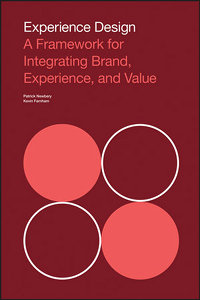Executives explore design, business planning
Posted by Elena del Valle on February 14, 2014

Experience Design
Photos: Wiley, Patrick Newbery, Kevin Farnham
In today’s business environment, it is necessary to support a brand through the product or service offerings across the entire lifeline of the customer relationship rather than only on the day he or she make a purchase. So say Patrick Newbery and Kevin Farnham who believe customers businesses should develop an “…understanding of how to look at opportunities, issues, strategies and tactics.” Achieving that, they argue, requires business managers and designers to collaborate and shift the way they approach their products.
“Apple’s reinvention of itself changed the world in many ways. The design of the end products and services is brilliant. But it wasn’t just how they were designed—it’s what Apple chose to design, and why, that mattered,” said Farnham, chief executive officer of Method. “Apple created value by redefining the experiences people could have with products they already wanted to use.”
Kevin Farnham, co-author, Experience Design
In Experience Design: A Framework for Integrating Brand, Experience and Value (Wiley, $32), a 232-page softcover book published in 2013, they explain their thinking. The book is divided into three sections, Context, Frameworks and Tools, and Moving Forward; and ten chapters: Thinking about Design, Thinking about Business, Thinking about Change, Thinking about Experience Design, Brand Frameworks and Tools, Product/Service Framework and Tools, Customer Journey Framework, Putting It Together, Getting Business to Act on Experience Design, and Working with Vendors.

“Value drives relevance which drives engagement, which is the best way to drive revenue,” said Newbery, Method’s chief strategy officer. “The age of image as brand is closing. Trying to fix the experience at the 11th hour through brilliant design alone cannot create value that doesn’t exist.”
The authors highlight that only 25 percent of new product innovations ever reach commercial launch, and only 45 percent of those meet profit goals, resulting in an 11 percent success rate.
They’re of the opinion that experience design provides business a reason to invite design to the table earlier than is common while making it possible for executives to understand how design can help solve problems that expand past look and feel. They suggest a company and its products benefit when they invite design contributors to the conversation early on in the development process.
The authors intended audience is primarily business folks who engage design or who manage key aspects of the customer experience and need to understand how to use design more effectively to meet business goals. Their secondary audience is “design professionals who are multi-disciplinary and looking to develop their skills and understanding about how to help clients understand how to plan for and evaluate design.”
Farnham is responsible for company strategy, global recruiting, and business development at his company. In the last twenty years, according to his bio, he has worked directly with business leaders from companies Apple, BBC, Microsoft, MoMA, Nike, Google, and TED Conferences. Newbery, a resident of Berkeley, relies on his experience with strategy, brand, innovation, and design to develop the tools and frameworks that his company uses to shape client engagements.

Click to buy Experience Design










